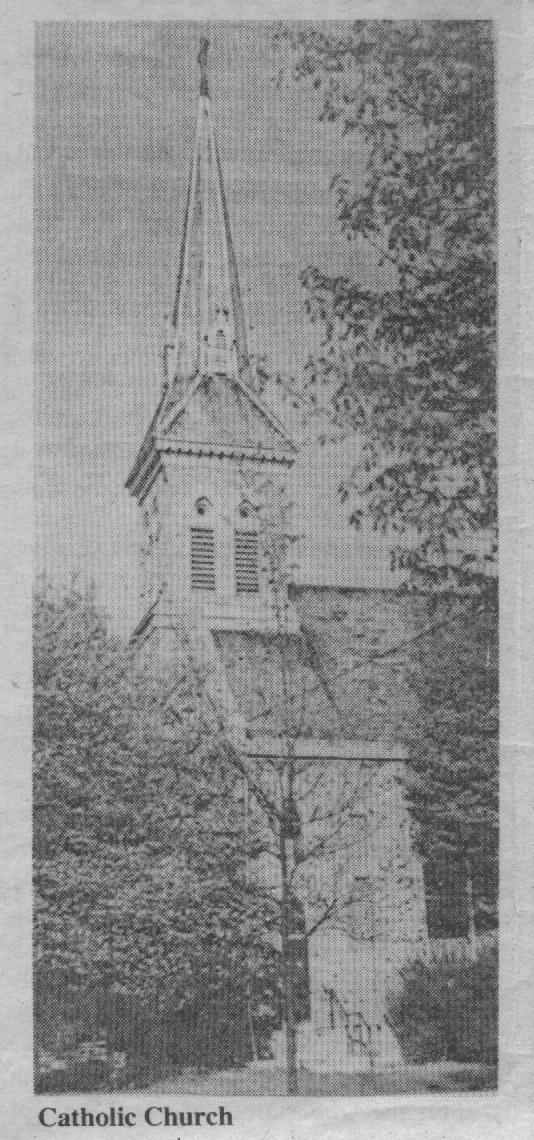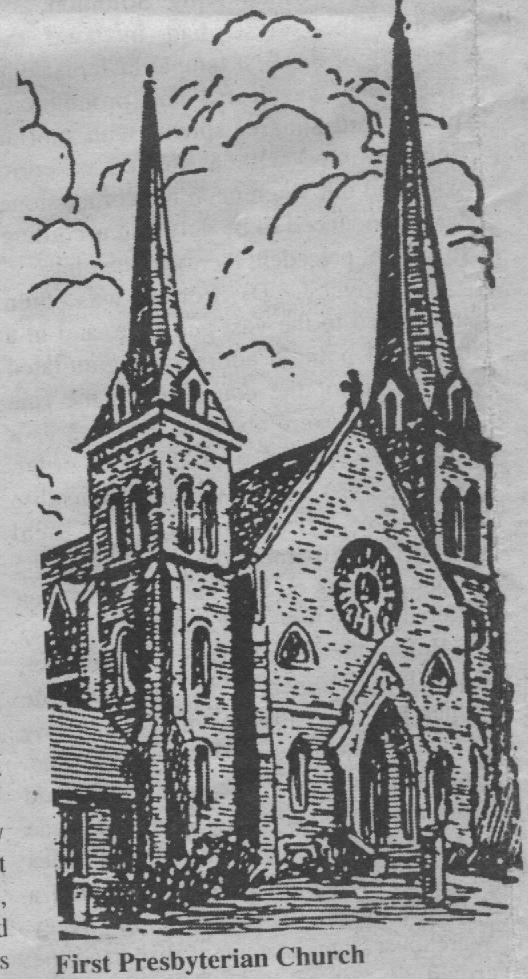CUMBERLAND LORE
A publication of the Leaf-Chronicle in cooperation with
the Clarksville-Montgomery County Historical Museum.
February 2000 issue
ON HISTORIC TRAILS - - EARLY CHURCHES
We will begin our tour at 714FranklinStreet,theImmaculate
Conception Church. According to Goodspeed's HISTORIES OF TENNESSEE, page
802, this congregation dates from 1830 when the first Catholic priest by
the name of Father Allemany, late Archbishop of California, visited this
place. By 1839 both the town and the number of Catholic families were growing.
According to Jean O'Connor's history of the church, Masses were said in
private homes at that time. Since no official church records prior to 1884
survive, it is not known who the first families were but allegedly the
names of Dunlavey and Boylan were among them. By December 3, 1844, the
"Clarksville Chronicle" reported: "We are requested to say that the new
Catholic Church of this town will be dedicated to the services of the Almighty
God on Sunday the 8th of December, being the second Sunday in Advent at
half past ten. The Rt. Rev. Dr. Miles, Bishop of Nashville will preform
the ceremony. There will be a service on the first Sunday every month at
half past ten in the morning and at four in the evening." The
first church was located on Washington Street between Fourth and Fifth
Streets, approximately across from 
Home Avenue. The Reverend Ivo Schacht from Belgium, ordained
in Nashville in 1843, became the first priest. He was followed by FatherLouis
Hoste, born in France. In 1848 Italian-born Father Aloysius Luigi Orengo,
who must have been especially beloved, for eventhough he left in 1855,
the
first Catholic school here was named St. Aloysius, perhaps honoring Father
Orengo as well as the Saint of Youth and Purity. This was 1860, the school
being established by Miss Hannah Murray, Irish born who came to Clarksville
from Nashville. She only lasted four years when she married John Conroy,
also Irish born. Miss Murray was followed by Miss Frances Bryne, who came
from St.Michael's, Robertson County. She lasted until 1965 when she married
James McDonnell. Miss Josephine Cauvin was a successor until she became
Mrs. Louis Michel of this city. (These must have been very attractive men.)
Following Father Hoste was the celebrated "Poet Priest"
of the South, Father Abram J. Ryan. Accounts vary as to whether he was
horn in Norfolk, Virginia. or Hagerstown, Maryland. No matter he was a
Southerner at heart. During his tenure here while he was boarding with
the John Conroys (1864-'65) he penned the poem, "The Conquered Banner",
Robert E. Lee being his hero. Since Father Ryan had started his powerful
preaching in Illinois, the "Chicago Tribune" dubbed him the "Traitor Priest".
He kept writing poetry until he was begged to publish his book of poetry
which was so popular, there were eleven subsequent editions. Immensely
popular in Clarksville Ryan was particularly close to Miss Hannah Murray
and Miss Fannie Bryne, as he has performed their marriage ceremonies.
Well, the parish had gradually grown from its struggling
infancy, especially during the 1840's when Irish workmen swelled the congregation.
Among these was the O'Sullivan (later Sullivan) family from County Carey.
Michael Sullivan eventually became mayor. It is his niece, Mary Jo Dozier
who became Clarksville's first councilwoman, who is serving her 25th year
at City Hall. Mary Jo's grandfather, Patrick O'Sullivan had come from Ireland
to build the railroads into Clarksville.
By 1876 the growing parish had outgrown the little brick
church on Washington Street (now College). This "new" church on the corner
of Seventh and Franklin was designed by C. G. Rosenplanter, a Memphis architect
who also designed the Methodist Church, the Courthouse, Tobacco Exchange
and the original Bailey Cobb and Howell Elementary Schools.
The "new" church, completed in 1880 had a seating capacity
of one hundred fifty. The interior was finished by Father Henry Jasper
after he became pastor in 1886. He was a highly skilled artisan.
In 1870, a two-story frame school building was erected
on Franklin at Seventh. The Sisters of Charity of Nazareth near Bardstown,
Kentucky, took charge of the school. Previously they had had only lay teachers.
This school, Sr. Mary's Parochial, later was I run by the Dominican Sisters
of St. Cecelia, Nashville. It closed in 1968.
Father John Nolan became priest in 1903. He was the son
of a Chattanooga contractor, and he had marvelous knowledge of designing
and building. He drew plans and built the present parochial residence as
well as another building for Mary's School and the home for the Sisters.
Proficient in wood carving. Father Nolan designed the present hand carved
high altar.
 St. Mary's Center, a new religious activities center, was
completed in 1975. Rufus Johnson, a Clarksvillian, was the architect.
St. Mary's Center, a new religious activities center, was
completed in 1975. Rufus Johnson, a Clarksvillian, was the architect.
The sanctuary, completed in 1880, is Victorian gothic
in style and features a bell tower with a tall spire at the central bay
of the facade. In the l900s a sand- -colored
cut stone veneer was added to the brick. The church is on the National
Register of Historic Places. A new place of worship was built in 1985 -
86
adjacent to the old sanctuary, and it's a modem building accommodating
itself to a larger congregation.
The First Presbyterian Church was organized on May 25,
1822,
under the guidance of Rev. Gideon Blackburn without a building or a regular
pastor for eighteen years. The church met in different homes or in the
courthouse or in the Masonic Hall when visiting preachers were available.
In 1836, the Rev. Consider Parish raised $2300 to build a House of Worship.
Mrs. Lucinda Elder Reynolds gave a lot on the northwest corner of Main
and Third for the new building. Miss Nora Cushman was asked to play the
melodeon for the church. The first regular pastor was the Rev. Andrew H.
Kerr, who served from 1841to 1846. The membership was 120.
Very rigid church rules in the early days caused members
to be suspended at times. Anna Cooper and Sarah Wilcox, two young girls
of the congregation, had a dancing party at the home of Anna's father,
Dr. C. R. Cooper, when he was away from town. Dr. Cooper was a physician
and an elder in the church, and he was extremely upset over this incident.
The girls were brought before the church session. Sarah Wilcox repented
before the session, but Anna refused. She said that she enjoyed dancing
and would do it again if she got the chance. Under the circumstances, the
session felt it must suspend the young lady from the communion of the church.
Dr. Delacey Wardlow was pastor until the occupation by
Federal troops. The church services were discontinued for those years -
three
of them - and Dr. Wardlow returned in July, 1865.
In 1875, the congregation began to raise money for a new church building.
The cost was $43,000. The cornerstone was laid in 1876 during the pastorate
of the Rev. J.W. Lupton. When it was dedicated in 1878, it was debt-free.
Dr. J. W. Ca1dwe1l took charge of the music of the church in 1878. The
organ was a water-powered organ, which was purchased for $3500 and was
designed by Professor Caldwell. When it was used, it lowered the water-pressure
in nearby homes so much that the congregation was forced to use bellows
system powered by small boys in the congregation. It kept them out of trouble
during the service, I'm sure. Mrs. A. H. LaSueur served as church Organist
for forty-three years.
Return to the Montgomery County Home Page

